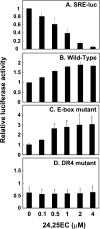SREBP-2 positively regulates transcription of the cholesterol efflux gene, ABCA1, by generating oxysterol ligands for LXR
- PMID: 16901265
- PMCID: PMC1698594
- DOI: 10.1042/BJ20060914
SREBP-2 positively regulates transcription of the cholesterol efflux gene, ABCA1, by generating oxysterol ligands for LXR
Abstract
Cholesterol accumulation and removal are regulated by two different transcription factors. SREBP-2 (sterol-regulatory-element-binding protein-2) is best known to up-regulate genes involved in cholesterol biosynthesis and uptake, whereas LXR (liver X receptor) is best known for up-regulating cholesterol efflux genes. An important cholesterol efflux gene that is regulated by LXR is the ATP-binding cassette transporter, ABCA1 (ATP-binding cassette transporter-A1). We have previously shown that statin treatment down-regulated ABCA1 expression in human macrophages, probably by inhibiting synthesis of the LXR ligand 24(S),25-epoxycholesterol. However, it was subsequently reported that ABCA1 expression is down-regulated by SREBP-2 through binding of SREBP-2 to an E-box element in ABCA1's proximal promoter. As statin treatment induces SREBP-2 activation, this may provide an alternative explanation for the statin-mediated down-regulation of ABCA1. In the present study, we employed a set of CHO (Chinese-hamster ovary) mutant cell lines to investigate the role of SREBP-2 in the regulation of ABCA1. We observed increased ABCA1 mRNA levels in SREBP-2-overexpressing cells and decreased levels in cells lacking a functional SREBP-2 pathway, which were restored when the SREBP-2 pathway was reinstated. Moreover, ABCA1 gene expression was positively associated with synthesis of 24(S),25-epoxycholesterol in these cell lines. In studies using a human ABCA1 promoter reporter assay, mutation of the E-box motif had a similar response as the wild-type construct to either statin treatment or addition of 24(S),25-epoxycholesterol. By contrast, these responses were completely ablated when the DR4 element to which LXR binds was mutated. These results support the idea that 24(S),25-epoxycholesterol and statin treatment influence ABCA1 transcription via supply of an LXR ligand and not through an SREBP-2/E-box-related mechanism. In addition, our results indicate a critical role of SREBP-2 as a positive regulator of ABCA1 gene expression by enabling the generation of oxysterol ligands for LXR.
Figures





Similar articles
-
Selective up-regulation of LXR-regulated genes ABCA1, ABCG1, and APOE in macrophages through increased endogenous synthesis of 24(S),25-epoxycholesterol.J Biol Chem. 2007 Feb 23;282(8):5207-16. doi: 10.1074/jbc.M611063200. Epub 2006 Dec 23. J Biol Chem. 2007. PMID: 17186944
-
Statins inhibit synthesis of an oxysterol ligand for the liver x receptor in human macrophages with consequences for cholesterol flux.Arterioscler Thromb Vasc Biol. 2004 Dec;24(12):2365-71. doi: 10.1161/01.ATV.0000148707.93054.7d. Epub 2004 Oct 28. Arterioscler Thromb Vasc Biol. 2004. PMID: 15514210
-
Sterol regulatory element-binding protein-2- and liver X receptor-driven dual promoter regulation of hepatic ABC transporter A1 gene expression: mechanism underlying the unique response to cellular cholesterol status.J Biol Chem. 2007 Jul 20;282(29):21090-9. doi: 10.1074/jbc.M701228200. Epub 2007 May 27. J Biol Chem. 2007. PMID: 17526932
-
Transcriptional regulatory networks in lipid metabolism control ABCA1 expression.Biochim Biophys Acta. 2005 Jun 15;1735(1):1-19. doi: 10.1016/j.bbalip.2005.04.004. Biochim Biophys Acta. 2005. PMID: 15922656 Review.
-
Non-steroidal LXR agonists; an emerging therapeutic strategy for the treatment of atherosclerosis.Recent Pat Cardiovasc Drug Discov. 2006 Jan;1(1):21-46. doi: 10.2174/157489006775244245. Recent Pat Cardiovasc Drug Discov. 2006. PMID: 18221072 Review.
Cited by
-
Cholesterol through the looking glass: ability of its enantiomer also to elicit homeostatic responses.J Biol Chem. 2012 Sep 28;287(40):33897-904. doi: 10.1074/jbc.M112.360537. Epub 2012 Aug 6. J Biol Chem. 2012. PMID: 22869373 Free PMC article.
-
SREBP2 promotes the viability, proliferation, and migration and inhibits apoptosis in TGF-β1-induced airway smooth muscle cells by regulating TLR2/NF-κB/NFATc1/ABCA1 regulatory network.Bioengineered. 2022 Feb;13(2):3137-3147. doi: 10.1080/21655979.2022.2026550. Bioengineered. 2022. PMID: 35037821 Free PMC article.
-
Sex-dependent effect of sublethal copper concentrations on de novo cholesterol synthesis in astrocytes and their possible links to variations in cholesterol and amyloid precursor protein levels in neuronal membranes.Biol Sex Differ. 2024 Jan 8;15(1):4. doi: 10.1186/s13293-023-00578-9. Biol Sex Differ. 2024. PMID: 38191520 Free PMC article.
-
Deletion of Scap in alveolar type II cells influences lung lipid homeostasis and identifies a compensatory role for pulmonary lipofibroblasts.J Biol Chem. 2009 Feb 6;284(6):4018-30. doi: 10.1074/jbc.M805388200. Epub 2008 Dec 11. J Biol Chem. 2009. PMID: 19074148 Free PMC article.
-
Linoleic acid suppresses cholesterol efflux and ATP-binding cassette transporters in murine bone marrow-derived macrophages.Lipids. 2014 May;49(5):415-22. doi: 10.1007/s11745-014-3890-y. Epub 2014 Mar 5. Lipids. 2014. PMID: 24595513 Free PMC article.
References
-
- Goldstein J. L., DeBose-Boyd R. A., Brown M. S. Protein sensors for membrane sterols. Cell. 2006;124:35–46. - PubMed
-
- Briggs M. R., Yokoyama C., Wang X., Brown M. S., Goldstein J. L. Nuclear protein that binds sterol regulatory element of low density lipoprotein receptor promoter. I. Identification of the protein and delineation of its target nucleotide sequence. J. Biol. Chem. 1993;268:14490–14496. - PubMed
-
- Costet P., Luo Y., Wang N., Tall A. R. Sterol-dependent transactivation of the ABC1 promoter by the liver X receptor/retinoid X receptor. J. Biol. Chem. 2000;275:28240–28245. - PubMed
-
- Edwards P. A., Kennedy M. A., Mak P. A. LXRs; oxysterol-activated nuclear receptors that regulate genes controlling lipid homeostasis. Vasc. Pharmacol. 2002;38:249–256. - PubMed
Publication types
MeSH terms
Substances
LinkOut - more resources
Full Text Sources
Other Literature Sources
Medical
Research Materials

